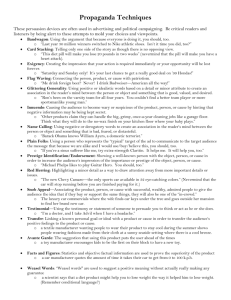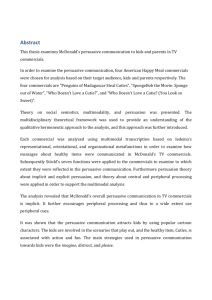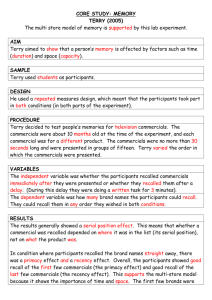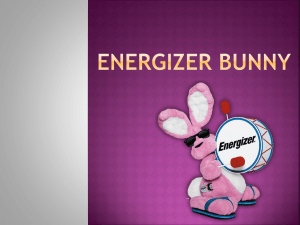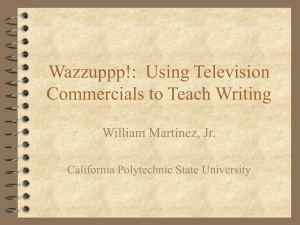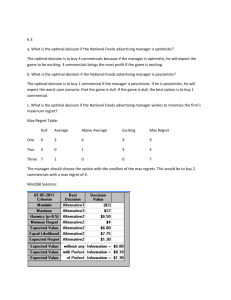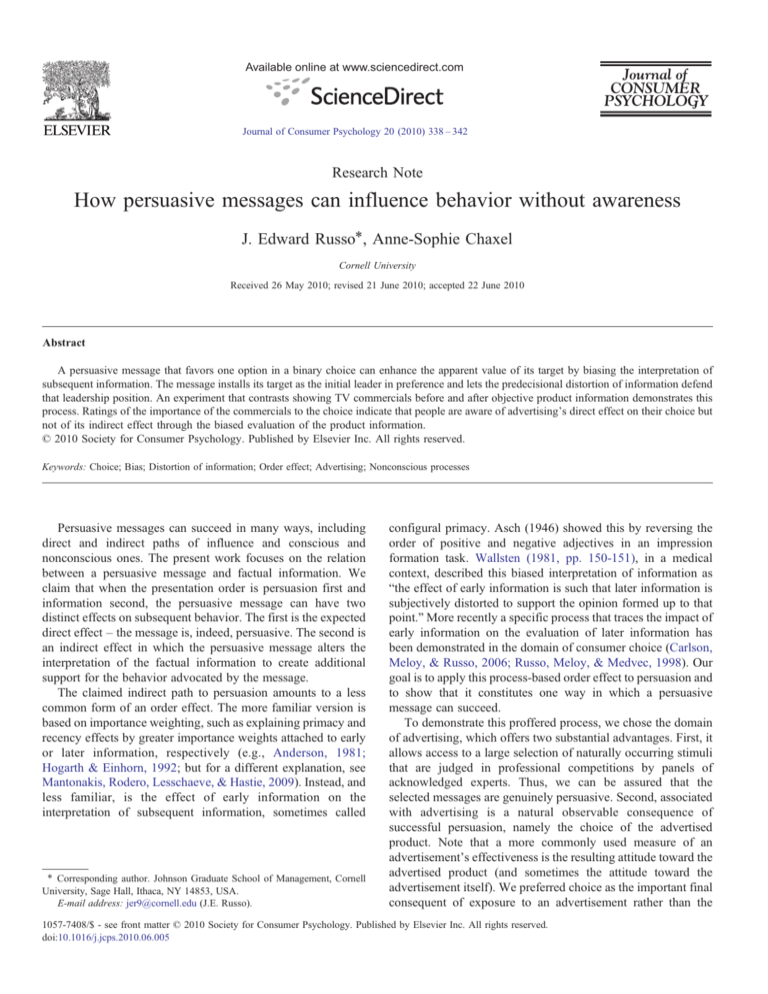
Available online at www.sciencedirect.com
Journal of
CONSUMER
PSYCHOLOGY
Journal of Consumer Psychology 20 (2010) 338 – 342
Research Note
How persuasive messages can influence behavior without awareness
J. Edward Russo⁎, Anne-Sophie Chaxel
Cornell University
Received 26 May 2010; revised 21 June 2010; accepted 22 June 2010
Abstract
A persuasive message that favors one option in a binary choice can enhance the apparent value of its target by biasing the interpretation of
subsequent information. The message installs its target as the initial leader in preference and lets the predecisional distortion of information defend
that leadership position. An experiment that contrasts showing TV commercials before and after objective product information demonstrates this
process. Ratings of the importance of the commercials to the choice indicate that people are aware of advertising's direct effect on their choice but
not of its indirect effect through the biased evaluation of the product information.
© 2010 Society for Consumer Psychology. Published by Elsevier Inc. All rights reserved.
Keywords: Choice; Bias; Distortion of information; Order effect; Advertising; Nonconscious processes
Persuasive messages can succeed in many ways, including
direct and indirect paths of influence and conscious and
nonconscious ones. The present work focuses on the relation
between a persuasive message and factual information. We
claim that when the presentation order is persuasion first and
information second, the persuasive message can have two
distinct effects on subsequent behavior. The first is the expected
direct effect – the message is, indeed, persuasive. The second is
an indirect effect in which the persuasive message alters the
interpretation of the factual information to create additional
support for the behavior advocated by the message.
The claimed indirect path to persuasion amounts to a less
common form of an order effect. The more familiar version is
based on importance weighting, such as explaining primacy and
recency effects by greater importance weights attached to early
or later information, respectively (e.g., Anderson, 1981;
Hogarth & Einhorn, 1992; but for a different explanation, see
Mantonakis, Rodero, Lesschaeve, & Hastie, 2009). Instead, and
less familiar, is the effect of early information on the
interpretation of subsequent information, sometimes called
⁎ Corresponding author. Johnson Graduate School of Management, Cornell
University, Sage Hall, Ithaca, NY 14853, USA.
E-mail address: jer9@cornell.edu (J.E. Russo).
configural primacy. Asch (1946) showed this by reversing the
order of positive and negative adjectives in an impression
formation task. Wallsten (1981, pp. 150-151), in a medical
context, described this biased interpretation of information as
“the effect of early information is such that later information is
subjectively distorted to support the opinion formed up to that
point.” More recently a specific process that traces the impact of
early information on the evaluation of later information has
been demonstrated in the domain of consumer choice (Carlson,
Meloy, & Russo, 2006; Russo, Meloy, & Medvec, 1998). Our
goal is to apply this process-based order effect to persuasion and
to show that it constitutes one way in which a persuasive
message can succeed.
To demonstrate this proffered process, we chose the domain
of advertising, which offers two substantial advantages. First, it
allows access to a large selection of naturally occurring stimuli
that are judged in professional competitions by panels of
acknowledged experts. Thus, we can be assured that the
selected messages are genuinely persuasive. Second, associated
with advertising is a natural observable consequence of
successful persuasion, namely the choice of the advertised
product. Note that a more commonly used measure of an
advertisement's effectiveness is the resulting attitude toward the
advertised product (and sometimes the attitude toward the
advertisement itself). We preferred choice as the important final
consequent of exposure to an advertisement rather than the
1057-7408/$ - see front matter © 2010 Society for Consumer Psychology. Published by Elsevier Inc. All rights reserved.
doi:10.1016/j.jcps.2010.06.005
J.E. Russo, A.-S. Chaxel / Journal of Consumer Psychology 20 (2010) 338–342
more intermediate result of a changed attitude (which would
presumably predict a subsequent observable behavior like a
choice).
That advertising can influence product purchases is well
established (e.g., Ailawady & Neslin, 1998; Tellis, Chandy, &
Thaivanich, 2000). There are also multiple credible views of
“how advertising works” (Vakratsas & Ambler, 1999) and some
notable empirical demonstrations (e.g., Hoch & Ha, 1986).
What there is not, to the best of our knowledge, is a specific
process that clearly links the advertising message to product
choice and whose operation can be observed over time. Our
goal is to introduce such a process, one which we believe acts to
influence subsequent behavior without any awareness and is, at
the same time, general enough to apply to other kinds of
persuasive messages.
339
not feel this feeling at all and 5 = I felt this feeling very strongly).
A single measure of affect was computed by averaging the ten
ratings, while reversing the sign for all negative feelings.
Results confirmed that Club Zephyr's commercial elicited
greater affect (1.22) than did Club Helios’ (0.47; t(10) = 1.87,
one-sided p b .05). We also checked that the two commercials
were judged to be equally persuasive. Although they were both
well executed award-winners, they might not have appeared
equally persuasive to our subject population. Thus, in addition
to the ten affect items, the same 12 participants responded to 10
items evaluating commercials’ persuasiveness on a seven-point
semantic differential scale from -3 to + 3 (MacKenzie & Lutz,
1989; Osgood, Suci, & Tannenbaum, 1957). The mean ratings
did not differ significantly, with the persuasiveness of the Club
Zephyr commercial (-.03) not even greater than that of the Club
Helios commercial (0.82; t (10) = -.87, one-sided p N .05).
Method
Product information
Stimuli
An experiment in which participants chose between two
beach resorts was designed to track the impact of commercials
for each resort on factual product information and then on the
actual choice. Two 60-secs, award-winning TV commercials for
beach resorts were selected, with neither being broadcast in the
United States at the time of the study. The ends of both
commercials were then altered in order to display our chosen
names for the two resorts, Club Zephyr and Club Helios. The
commercial for Club Zephyr showed a diverse series of
beautifully photographed vacation scenes, complemented by
slow, relaxing music. The Club Helios commercial began with
an icon-filled computer screen and the background noise of a
busy office. The icons were gradually removed to reveal a beach
scene as the computer screen's wall paper, while the office noise
gradually disappeared leaving only the sound of gentle waves.
Our process for linking advertising to choice required a
difference between the two commercials that would lead to one
advertised resort becoming the more preferred or leading
alternative for a majority of participants. Thus, besides being
executed well enough to win awards, the two commercials were
also selected for their differential affect compatibility with the
product category. This meant that we wanted one of them (Club
Zephyr) to be more affectively compatible with beach resorts
and, in particular, with our participant population of students
and the cover scenario of selecting a resort for a Spring Break
vacation. Because the goal of such an experience focuses on
relaxation, youthful fun, getting away from winter, etc., we
sought two commercials that differed in positive affect. Note
that Club Zephyr's commercial was affectively positive
throughout, while the Club Helios commercial was not. This
was why we viewed the former as more affectively compatible
with the choice setting.
We checked this presumed difference by showing one
commercial to each of 12 participants from the same subject
population. After watching the commercial they responded to
ten items (Burke & Edell, 1989; Edell & Burke, 1987) that
evaluated its positive affect on a 5-point unipolar scale (1 = I did
The factual product information on which the choice of a
resort was based consisted of five separate units. Each one
covered both resorts in a narrative of about 100 words (range:
78-135) that were devoted to the following topics: amenities,
atmosphere, club activities, location, and a travel guide's
descriptions. Each piece of information was written, pretested,
and rewritten as necessary until it favored neither resort, that is,
until it was roughly neutral or nondiagnostic. The five units
were presented in a random order that was reversed for half of
the participants. This factor had no impact on any result and is
not discussed further.
After each piece of persuasive information was displayed,
participants were asked for two intermediate responses that
tracked the progress of their decisions (Meloy & Russo, 2004).
They first rated a unit's persuasive value on a scale from 1 to 9,
where the endpoints meant that in the participant's judgment the
piece of product information “strongly favored” one or the other
resort and 5 meant “favored neither”. They then indicated which
resort was tentatively leading in overall preference and by how
much on a 50-to-100 scale. The first response provided an
evaluation of each piece of product information; the second, a
continually updated cumulative preference for one resort or the
other.
Proposed process
The process that we predicted would generate an indirect
effect of the commercials on choice relied on a phenomenon
known as the predecisional distortion of information (Brownstein, 2003; Carlson et al., 2006; Russo, Medvec, & Meloy,
1996). The evaluation of a unit of information is biased toward
whichever alternative is currently leading. If the advertising
message for Club Zephyr is more persuasive, then it should
install Zephyr as the leading resort for most viewers. Because of
Club Zephyr's presumed initial leadership for a majority of
viewers, the five pieces of product information should be
distorted, on average, to favor Zephyr. Without such a bias, any
initial preference should gradually be diluted as one
340
J.E. Russo, A.-S. Chaxel / Journal of Consumer Psychology 20 (2010) 338–342
nondiagnostic piece of information after another is encountered.
Note that if the commercials were seen after the product
information, they still might affect the choice. However, this
effect would derive only from a direct influence of the
commercials on choice, and not from their ability to induce
the distortion of the product information (the indirect effect).
Thus, the proportion choosing Club Zephyr should be greater
when the two commercials are seen before the product
information than when seen after that same information – but
only so long as there was a nonzero indirect effect.
Also important was people’s awareness of the pro-Zephyr
distortion of product information. If people were unaware of
this bias, that is, if the indirect effect was nonconscious, it was
unlikely that they could eliminate or even reduce its influence
on their decisions. Awareness could be determined from the
rated importance of the commercials (relative to the five pieces
of information) when the commercials were seen before versus
after the product information. Thus, participants were asked to
assigned importance weights to the two commercials and five
pieces of information (by dividing 100 points among the seven
items so as to “describe the importance of each… to your final
choice”). If there was no difference in the commercials’ rated
importance when they were seen before versus after the product
information, then people had to be unaware of the indirect
influence of the commercials on choice derived from predecisional distortion.
Because the commercials were two of only seven units of
information and because they were so well executed, participants were expected to be aware of the (direct) influence of the
commercials on their choices. However, they might still have
underestimated this effect. Because being influenced by
advertising can be viewed as being manipulated by others
(e.g., Calfee & Ringold, 1994), participants may have preferred
to perceive a smaller effect. To test this, we also asked
participants to estimate the importance that “a typical student”
would assign to the two commercials and five pieces of
information If the work on naïve realism (Ross & Ward, 1995;
1996) applies to advertising messages and product choice,
namely that “others…are more susceptible to biasing influences
than we are ourselves” (Pronin, Gilovich, & Ross, 2004, p.
782), then the importance of the commercials to others might
exceed the same ratings for the self. Thus, not only might the
indirect effect of the persuasive advertisements have gone
unrecognized, but there was reason to believe that the direct
effect may have been underestimated.
Design
The experimental design consisted of five conditions. In the
first (commercials before) participants saw the two commercials, read and evaluated the five pieces of information, made a
final choice, and assigned importance weights. The second
condition (commercials after) replicated the first with the single
change that the commercials followed rather than preceded the
product information. These two experimental conditions formed
the core of the design.
They were augmented by three control conditions. In the first
(no commercials), only the product information was shown.
Because this information was nondiagnostic, the proportion
choosing Club Zephyr should not have departed significantly
from .50. Besides confirming the overall neutrality of the five
pieces of information, this control condition also provided
baserates for the amount of predecisional distortion and two
other process measures that are introduced below.
A second control condition (commercials only) showed only
the two commercials and asked only for a preference between
the two advertised resorts. Its purpose was solely to confirm our
presumption that a majority of participants would lean toward
Club Zephyr after seeing the two commercials in the
commercials-before condition.
Finally, a third control condition (no measures) replicated the
first experimental condition, but without the measurement of
diagnosticity and the identification of a tentatively preferred or
leading alternative after each unit of information. This nomeasures condition allowed a test of whether requiring
participants to provide these two measures contributed in any
way to the actual choice. That is, it tested for any demand effect
caused by the measurement procedure.
Participants
The experimental participants were 203 students who
volunteered for a cash payment. Six participants failed to
complete the entire questionnaire and were removed from all
analyses.
Results
Brand choice
The results from the first control condition (no commercials)
confirmed a neutral baseline for the proportion of participants
choosing Club Zephyr, .49 (22 of 45) when only nondiagnostic
product information was provided. The results of the second
control condition (commercials only) confirmed that, after
participants saw the two commercials (and only the two
commercials), a majority of them, .68 (15 of 22), preferred Club
Zephyr.
We turn now to the main results. The first test of the claimed
process of advertising's influence on choice was whether the
commercials-before condition yielded a greater choice proportion than the baseline. As shown in Table 1, this value was .68
(30 of 44), a proportion significantly above the .49 of the control
(Fisher's exact test, one-sided mid-p b .05). Note that the final
proportion choosing Club Zephyr was identical to that in the
control condition that showed only the two commercials (.68)
and was designed to indicate the proportion initially leaning
toward that resort. Thus, the proposed mechanism of information distortion to support the leading alternative seemed
sufficient to prevent any dilution of the initial leaning toward
Club Zephyr despite five units of neutral product information.
The second test of our main prediction compared the
commercials-after group with the control. When the
J.E. Russo, A.-S. Chaxel / Journal of Consumer Psychology 20 (2010) 338–342
Table 1
Condition
Proportion Mean
Mean
Proportion Importance
Choosing Distortion Initial
Never
Weights of
Club
Confidence Reversing Commercials
Zephyr
Control
.49
(no com'ls)
Commercials .68
before
Commercials .52
after
.47
0.64
.42
–
1.02
0.70
.70
19.2
.41
0.61
.52
18.9
commercials followed the product information they could not
have driven predecisional distortion and could only have
exerted a direct effect on choice. The choice proportion of
Zephyr in this condition was .53 (23 of 44), a value not reliably
greater than the .49 of the control group (Fisher's exact test,
one-sided mid-p N .05). For completeness, we compared the
commercials-before and commercials-after groups. The .68 of
the commercials-before group was marginally greater than the
.53 of the commercials-after group (Fisher's exact test, onesided mid-p b .10).
The comparison of the commercials-before (.68) to the
control condition (.49) reflected the combined indirect and
direct effects of advertising on product choice. The second
comparison, commercials-after (.53) to the control captured
only the direct effect on choice. Thus, the contrast between the
two comparisons isolated the indirect influence, presumably
through the commercials leading to the distortion of product
information to support Club Zephyr. An examination of the
levels of predecisional distortion should verify such an
influence.
For completeness, the corresponding choice proportion in
the no-measures condition was .69, nearly identical to the .68 of
the commercials-before condition. Thus, requiring the two
intermediate responses that tracked the predecisional distortion
of information had no apparent effect on choice.
Information distortion
If predecisional distortion of information drove the observed
differences in choice proportions, then distortion should have
been significantly greater when the commercials came first than
in either the commercials-after condition or in the first control
(no commercials) condition. Distortion was computed as the
signed absolute difference between the reported evaluation of a
unit of information (on the 1-to-9 scale) and the neutral value of
5. This difference was signed positively when the evaluation fell
on the same side of the scale as the leading resort and negatively
otherwise. The mean distortions were: in the commercialsbefore condition, 1.02; in the commercials-after condition, .41;
and in the control group, .47. An ANOVA with planned
comparisons using a Tukey test revealed that the commercialsbefore condition differed significantly from both the commercials-after group (t (529) = 2.69, p b .05) and the control group (t
(529) = 2.47, p b .05), but that the latter two conditions did not
differ from each other (t (529) = .23, p N .05). This pattern of
341
distortions paralleled the pattern of choice proportions. It
provided clear support for the proposed process of a commercial
creating leadership for its brand and the predecisional distortion
of subsequent information biasing the final product choice.
Initial confidence and stickiness of preference
The process that we argue underlay the indirect effect of the
commercials on product choice can be summarized as follows:
The commercials provided a head start in preference that
predecisional distortion then supported. If this was true, we
should have observed two manifestations of the process in the
commercials-before condition, greater initial confidence in the
leading resort (the head start) and more participants staying with
their initial leader as the product information was distorted to
support the leading resort. We computed both the mean initial
confidence and the proportion of participants who remained
with their initial preference throughout. These values are shown
in Table 1 for all three conditions.
Initial confidence was .70 in the commercials-before
condition, .61 in the commercials-after condition, and .64 in
the control condition. An ANOVA with Tukey planned
comparisons revealed a difference between commercials-before
and both other groups (for both, one-sided p b .05) but not
between the commercials-after and the control conditions.
The proportion of participants who remained with their
initial preference throughout was reliably greater in the
commercials-before condition (.70) than in both the commercials-after (.52) and control (.42) conditions (Fisher's exact test,
mid-p b .05 for both). Again, there was no reliable difference
between the commercials-after and control conditions (Fisher's
exact test, mid-p N .05).
Awareness
Were participants aware of the indirect effect of the
commercials, that is, of their effect on product choice through
their biasing the evaluation of product information? Of course,
participants perceived a direct effect, possibly greater than
normal because the commercials were award winners and the
product information was nondiagnostic. That direct effect was
manifest in the importance values collected in the commercialsafter condition where only the direct effect could occur. In this
condition the mean importance of the two commercials
combined was 18.9 (out of 100). If people had been aware of
the biasing effect of the commercials on product information
and on their choice of a resort (i.e., aware of the commercials’
indirect effect), then the corresponding value in the commercials-before condition should have been greater. This value was
19.2, not reliably different from that in the commercials-after
condition (t (98) = .096, p N .05). Thus, there was no evidence
that people recognized the indirect impact of the commercials
on their choices.
Did participants’ estimates of the commercials’ importance
differ from their corresponding estimates for “a typical
student”? In accord with naïve realism, participants believed
that the commercials affected others’ choices (24.8)
342
J.E. Russo, A.-S. Chaxel / Journal of Consumer Psychology 20 (2010) 338–342
significantly more than they influenced their own (19.1 over
both conditions; t (176) = 2.50, p b .01). In other words, even
when assessing the direct influence of the commercials, of
which the participants were quite aware, they underestimated
their influence on themselves relative to others.
it were, it would also be in their best interest not to discuss their
use of it. Might this be why it has not been described and
documented before?
Discussion
Ailawady, K. L., & Neslin, S. A. (1998). The effect of promotion on
consumption: Buying more and consuming it faster. Journal of Marketing
Research, 35, 390−398.
Anderson, N. H. (1981). Foundations of Information Integration Theory. New
York: Academic Press.
Brownstein, A. L. (2003). Biased predecision processing. Psychological
Bulletin, 129(4), 545−569.
Burke, M. C., & Edell, J. A. (1989). The impact of feelings on ad-based affect
and cognitions. Journal of Marketing Research, 16, 69−83.
Calfee, J. E., & Ringold, D. J. (1994). The 70% majority: Enduring consumer
beliefs about advertising. Journal of Public Policy and Marketing, 13,
228−238.
Carlson, K. A., Meloy, M. G., & Russo, J. E. (2006). Leader-drive primacy:
Using attribute order to affect consumer choice. Journal of Consumer
Research, 32, 513−518.
Edell, J. A., & Burke, M. C. (1987). The power of feelings in understanding
advertising effects. Journal of Consumer Research, 14, 421−433.
Hoch, S. J., & Ha, Y. -W. (1986). Consumer learning: Advertising and the
ambiguity of product experience. Journal of Consumer Research, 13,
221−233.
Hogarth, R. M., & Einhorn, H. J. (1992). Order effects in belief updating: The
belief-adjustment model. Cognitive Psychology, 24, 1−55.
MacKenzie, S. B., & Lutz, R. J. (1989). An empirical examination of the
structural antecedents of attitude toward the ad in an advertising pretesting
context. Journal of Marketing, 53, 48−65.
Mantonakis, A., Rodero, P., Lesschaeve, I., & Hastie, R. (2009). Order in
choice: Effects of serial position on preferences. Psychological Science, 20,
1309−1312.
Meloy, M. G., & Russo, J. E. (2004). Binary choice under instructions to select
versus reject. Organizational Behavior and Human Decision Processes, 93,
114−128.
Osgood, C. E., Suci, G. J., & Tannenbaum, P. H. (1957). The Measurement of
Meaning. Urbana, Ill: University of Illinois Press.
Pronin, E., Gilovich, T., & Ross, L. (2004). Objectivity in the eye of the
beholder: Divergent perceptions of bias in self versus others. Psychological
Review, 111, 781−799.
Ross, L., & Ward, A. (1995). Psychological barriers to dispute resolution. In M.
Zanna (Ed.), Advances in experimental social psychology, Vol. 27. (pp.
255−304)San Diego, CA: Academic Press.
Ross, L., & Ward, A. (1996). Naive realism in everyday life: Implications for
social conflict and misunderstanding. In T. Brown, E. S. Reed, & E. Turiel
(Eds.), Values and knowledge. The Jean Piaget Symposium Series
(pp. 103−135). Hillsdale, NJ: Erlbaum.
Russo, J. E., Medvec, V. H., & Meloy, M. G. (1996). The distortion of
information during decisions. Organizational Behavior and Human
Decision Processes, 66, 102−110.
Russo, J. E., Meloy, M. G., & Medvec, V. H. (1998). Predecisional distortion of
information by auditors and salespersons. Management Science, 46, 13−27.
Tellis, G. J., Chandy, R. K., & Thaivanich, P. (2000). Which ad works, when,
where, and how often? Modeling the effects of direct television advertising.
Journal of Marketing Research, 37, 32−46.
Vakratsas, D., & Ambler, T. (1999). How advertising really works: What do we
really know? Journal of Marketing, 63, 26−43.
Wallsten, T. S. (1981). Physician and Medical Student Bias in Evaluating
Diagnostic Information. Medical Decision Making, 2, 145−164.
We set out to verify the ability of a specific, observable
process to explain the influence of a persuasive message on an
important consequent behavior, namely choice. All observed
results were compatible with the proposed process of a more
effective message installing its target as the initial leader and
letting the biasing of subsequent information help to preserve
that head start through to the actual choice. Maybe just as
important, individuals were shown to be unaware of this
influence on their own behavior, increasing the difficulty of
finding and fixing it.
The present work advances our knowledge of persuasive
processes in at least two ways. First, unlike all previous
demonstrations of a “head start” leading to biased evaluation of
information, we have used naturally occurring persuasive
messages, namely TV commercials, to provide that initial
leadership. That is, instead of manipulating the cover story
(Russo et al., 1996) or the order of information (Carlson et al.,
2006), we used real world stimuli that are designed to influence
choice and seen every day by TV viewers. Second, we showed
that people are unaware of the indirect influence of those TV
commercials, even though they are quite aware of their direct
influence. Finally, there is a methodological contribution,
namely revealing that the collection of the two intermediate
responses that are necessary to track information distortion had
no effect on the final choice. This null result helps to reduce one
of the persistent concerns about process-tracing methods,
namely their alteration of the process that they are supposed
to reveal. It seems that although our method necessarily
interrupted and undoubtedly slowed the choice process, those
and any other changes did not affect the choices themselves.
We suggest that the process demonstrated in our study can
occur with other persuasive communications that successfully
create an initial leaning toward a targeted position. Might a
political message create such a leaning, especially when a
candidate or legislative initiative is new and largely unknown to
voters? Might an implanted article in a magazine create an
initial favorable image of a person, place or project, one that
could bias the interpretation of later objective information?
Finally, might word of mouth create an initial opinion on any
range of message targets, from new neighbors to new products?
These are only meant to illustrate some possible applications of
the process that we have demonstrated. We wonder whether this
process has, for a long time, been well understood and used by
professionals who are paid to manipulate opinion. Of course, if
References

